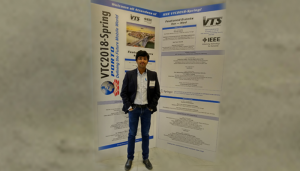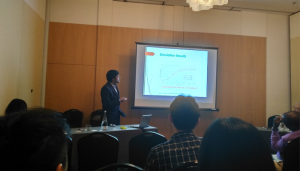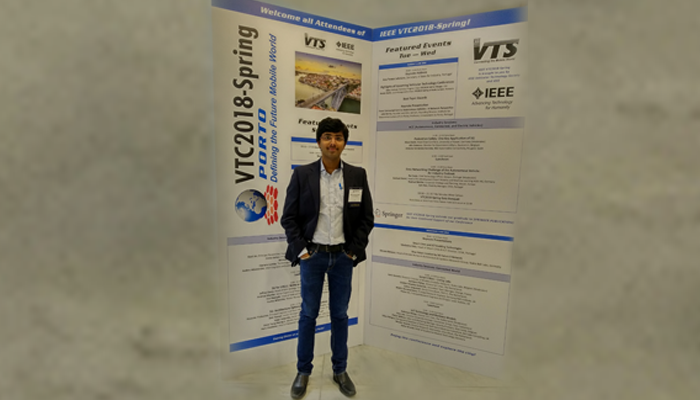The existing mobile network technology (2G, 3G and 4G) is unable to accommodate an ever-increasing mobile phone subscriber base putting pressure on limited data. Add to this: Over-stressed and clogged mobile networks. We met up with Shaik Zakir Hussain, MS by Research student from the Signal Processing and Communications Research Centre (SPCRC) who chatted about the ongoing research there which has been projected to effectively tackle both these issues.
An acronym for ‘Non-Orthogonal Multiple Access’, NOMA is the stuff that gets network and telecom engineers all excited. Very simplistically put, it uses a technique never used before in 2G, 3G or 4G where it separates signals through the power domain. 26-year-old Zakir Hussain should know. He’s back from Porto, Portugal where he presented two papers at the 2018 IEEE 87th Vehicular Technology Conference VTC2018-Spring in June. In the paper on ‘Sum Rate Maximization in NOMA Relay Networks’, Zakir explains that the efficiency of NOMA technology in IoT applications was analyzed theoretically and via computer simulations while in ‘NOMA in Cognitive Relay Networks, he applied developed algorithm in cognitive networks and analyzed its performance. Zakir’s research work in NOMA and Cognitive Radio is supported by ‘Visvesvaraya Young Faculty Research Fellowship” of Ministry of Electronics & Information Technology(MeitY) in the form of grants for presenting papers and research-work at national and international conferences and other research expenses for a maximum of five years, as well as by CSIR who supported his travel expenses.


Emergence of 5G
While 5G typically translates to greater data speed and faster connectivity for most laypeople, for Zakir Hussain, the thought of its full potential is exhilarating. 4G partially answered the demand for huge data as well as faster and higher quality services brought about by the advent of the smartphone. But Zakir sees 5G as technology that will completely overhaul the world of communication. “It is going to connect every digital device around us and make them talk among themselves. It can be your fridge and the thermostat at home, or your car talking to other cars on road to make better navigation decisions,” he says excitedly. According to IEEE COMSOC Technology News Special Issue on 5G, ‘when compared to the 4G network, 5G should achieve 1000 times the system capacity, 10 times the spectral efficiency, energy efficiency and data rate (i.e., peak data rate of 10 Gb/s for low mobility and peak data rate of 1 Gb/s for high mobility), and 25 times the average cell throughput’.
Research Beckoned
Talking of his IIIT-H journey, Zakir mentions that from his undergrad days he was fascinated by mobile and satellite communications. His strong mathematical background tilted the scales in favour of his first loves – communications and signal processing. After a short industry stint with TCS, he gave it up to pursue his passion towards research. “I wanted to work on new challenging problems and hence opted for the SPCRC lab here. I am very happy to be part of research which is going to be part of next generation wireless communication systems i.e., 5G,” he says.


SPRC Research and 5G
Zakir’s research work majorly revolves around NOMA and Cognitive radio which are touted as the pillars of 5G. He says that the ability to achieve superior spectral efficiency by serving multiple users at the same time and with the same frequency resource, increase in the number of simultaneously served users, and lower latency, make them an emerging technology. In fact he plans on continuing research towards developing algorithms suitable for 5G in the form of a PhD. “When 5G is fully established, the 5G supported smartphone will not be just another phone. It is going to be like “the world in your pocket” by which you can control almost every electrical equipment around you and it will be the start of new technological era”, he exclaims.
What’s In A Name?
Ask him about the inspiration behind his name, this Army brat who hails from Guntur in Andhra Pradesh says that it is manifold. His christening was the result of either the 3rd President of India, and recipient of the Bharat Ratna – Zakir Hussain, whom his dad held in high esteem or the famous tabla maestro, who his aunts and uncles are great fans of. “I have grown up, advised at different stages of my academic career, to live up to those personalities mentioned above”, says Zakir. Interestingly enough, Zakir is currently learning to play the piano; “So the next time someone asks me, “Do you play the Tabla?,” then I can confidently say, “I play the Piano”. Apart from playing chess, Zakir is also a huge fan of astronomy and extra-terrestrial life explorations. He spends his spare time reading latest discoveries about space and the universe.
Sarita Chebbi is a compulsive early riser. Devourer of all news. Kettlebell enthusiast. Nit-picker of the written word especially when it’s not her own.

